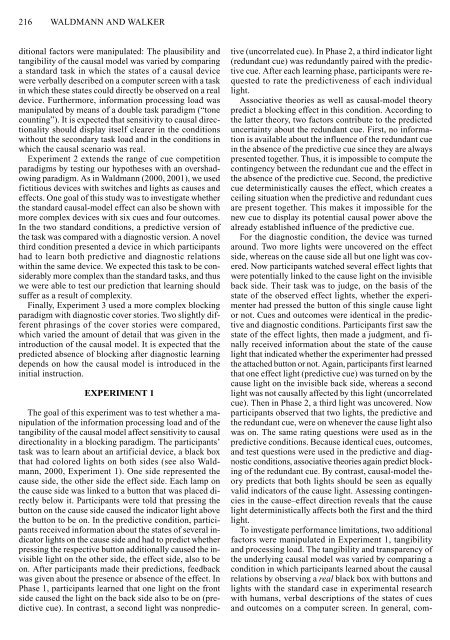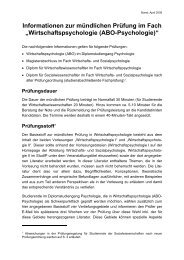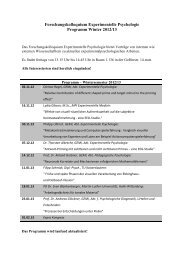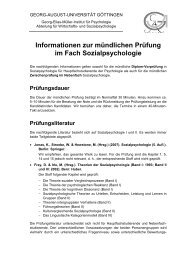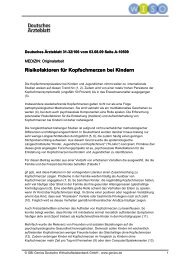Competence and performance in causal learning
Competence and performance in causal learning
Competence and performance in causal learning
Create successful ePaper yourself
Turn your PDF publications into a flip-book with our unique Google optimized e-Paper software.
216 WALDMANN AND WALKER<br />
ditional factors were manipulated: The plausibility <strong>and</strong><br />
tangibility of the <strong>causal</strong> model was varied by compar<strong>in</strong>g<br />
a st<strong>and</strong>ard task <strong>in</strong> which the states of a <strong>causal</strong> device<br />
were verbally described on a computer screen with a task<br />
<strong>in</strong> which these states could directly be observed on a real<br />
device. Furthermore, <strong>in</strong>formation process<strong>in</strong>g load was<br />
manipulated by means of a double task paradigm (“tone<br />
count<strong>in</strong>g”). It is expected that sensitivity to <strong>causal</strong> directionality<br />
should display itself clearer <strong>in</strong> the conditions<br />
without the secondary task load <strong>and</strong> <strong>in</strong> the conditions <strong>in</strong><br />
which the <strong>causal</strong> scenario was real.<br />
Experiment 2 extends the range of cue competition<br />
paradigms by test<strong>in</strong>g our hypotheses with an overshadow<strong>in</strong>g<br />
paradigm. As <strong>in</strong> Waldmann (2000, 2001), we used<br />
fictitious devices with switches <strong>and</strong> lights as causes <strong>and</strong><br />
effects. One goal of this study was to <strong>in</strong>vestigate whether<br />
the st<strong>and</strong>ard <strong>causal</strong>-model effect can also be shown with<br />
more complex devices with six cues <strong>and</strong> four outcomes.<br />
In the two st<strong>and</strong>ard conditions, a predictive version of<br />
the task was compared with a diagnostic version. A novel<br />
third condition presented a device <strong>in</strong> which participants<br />
had to learn both predictive <strong>and</strong> diagnostic relations<br />
with<strong>in</strong> the same device. We expected this task to be considerably<br />
more complex than the st<strong>and</strong>ard tasks, <strong>and</strong> thus<br />
we were able to test our prediction that learn<strong>in</strong>g should<br />
suffer as a result of complexity.<br />
F<strong>in</strong>ally, Experiment 3 used a more complex block<strong>in</strong>g<br />
paradigm with diagnostic cover stories. Two slightly different<br />
phras<strong>in</strong>gs of the cover stories were compared,<br />
which varied the amount of detail that was given <strong>in</strong> the<br />
<strong>in</strong>troduction of the <strong>causal</strong> model. It is expected that the<br />
predicted absence of block<strong>in</strong>g after diagnostic learn<strong>in</strong>g<br />
depends on how the <strong>causal</strong> model is <strong>in</strong>troduced <strong>in</strong> the<br />
<strong>in</strong>itial <strong>in</strong>struction.<br />
EXPERIMENT 1<br />
The goal of this experiment was to test whether a manipulation<br />
of the <strong>in</strong>formation process<strong>in</strong>g load <strong>and</strong> of the<br />
tangibility of the <strong>causal</strong> model affect sensitivity to <strong>causal</strong><br />
directionality <strong>in</strong> a block<strong>in</strong>g paradigm. The participants’<br />
task was to learn about an artificial device, a black box<br />
that had colored lights on both sides (see also Waldmann,<br />
2000, Experiment 1). One side represented the<br />
cause side, the other side the effect side. Each lamp on<br />
the cause side was l<strong>in</strong>ked to a button that was placed directly<br />
below it. Participants were told that press<strong>in</strong>g the<br />
button on the cause side caused the <strong>in</strong>dicator light above<br />
the button to be on. In the predictive condition, participants<br />
received <strong>in</strong>formation about the states of several <strong>in</strong>dicator<br />
lights on the cause side <strong>and</strong> had to predict whether<br />
press<strong>in</strong>g the respective button additionally caused the <strong>in</strong>visible<br />
light on the other side, the effect side, also to be<br />
on. After participants made their predictions, feedback<br />
was given about the presence or absence of the effect. In<br />
Phase 1, participants learned that one light on the front<br />
side caused the light on the back side also to be on (predictive<br />
cue). In contrast, a second light was nonpredictive<br />
(uncorrelated cue). In Phase 2, a third <strong>in</strong>dicator light<br />
(redundant cue) was redundantly paired with the predictive<br />
cue. After each learn<strong>in</strong>g phase, participants were requested<br />
to rate the predictiveness of each <strong>in</strong>dividual<br />
light.<br />
Associative theories as well as <strong>causal</strong>-model theory<br />
predict a block<strong>in</strong>g effect <strong>in</strong> this condition. Accord<strong>in</strong>g to<br />
the latter theory, two factors contribute to the predicted<br />
uncerta<strong>in</strong>ty about the redundant cue. First, no <strong>in</strong>formation<br />
is available about the <strong>in</strong>fluence of the redundant cue<br />
<strong>in</strong> the absence of the predictive cue s<strong>in</strong>ce they are always<br />
presented together. Thus, it is impossible to compute the<br />
cont<strong>in</strong>gency between the redundant cue <strong>and</strong> the effect <strong>in</strong><br />
the absence of the predictive cue. Second, the predictive<br />
cue determ<strong>in</strong>istically causes the effect, which creates a<br />
ceil<strong>in</strong>g situation when the predictive <strong>and</strong> redundant cues<br />
are present together. This makes it impossible for the<br />
new cue to display its potential <strong>causal</strong> power above the<br />
already established <strong>in</strong>fluence of the predictive cue.<br />
For the diagnostic condition, the device was turned<br />
around. Two more lights were uncovered on the effect<br />
side, whereas on the cause side all but one light was covered.<br />
Now participants watched several effect lights that<br />
were potentially l<strong>in</strong>ked to the cause light on the <strong>in</strong>visible<br />
back side. Their task was to judge, on the basis of the<br />
state of the observed effect lights, whether the experimenter<br />
had pressed the button of this s<strong>in</strong>gle cause light<br />
or not. Cues <strong>and</strong> outcomes were identical <strong>in</strong> the predictive<br />
<strong>and</strong> diagnostic conditions. Participants first saw the<br />
state of the effect lights, then made a judgment, <strong>and</strong> f<strong>in</strong>ally<br />
received <strong>in</strong>formation about the state of the cause<br />
light that <strong>in</strong>dicated whether the experimenter had pressed<br />
the attached button or not. Aga<strong>in</strong>, participants first learned<br />
that one effect light (predictive cue) was turned on by the<br />
cause light on the <strong>in</strong>visible back side, whereas a second<br />
light was not <strong>causal</strong>ly affected by this light (uncorrelated<br />
cue). Then <strong>in</strong> Phase 2, a third light was uncovered. Now<br />
participants observed that two lights, the predictive <strong>and</strong><br />
the redundant cue, were on whenever the cause light also<br />
was on. The same rat<strong>in</strong>g questions were used as <strong>in</strong> the<br />
predictive conditions. Because identical cues, outcomes,<br />
<strong>and</strong> test questions were used <strong>in</strong> the predictive <strong>and</strong> diagnostic<br />
conditions, associative theories aga<strong>in</strong> predict block<strong>in</strong>g<br />
of the redundant cue. By contrast, <strong>causal</strong>-model theory<br />
predicts that both lights should be seen as equally<br />
valid <strong>in</strong>dicators of the cause light. Assess<strong>in</strong>g cont<strong>in</strong>gencies<br />
<strong>in</strong> the cause–effect direction reveals that the cause<br />
light determ<strong>in</strong>istically affects both the first <strong>and</strong> the third<br />
light.<br />
To <strong>in</strong>vestigate <strong>performance</strong> limitations, two additional<br />
factors were manipulated <strong>in</strong> Experiment 1, tangibility<br />
<strong>and</strong> process<strong>in</strong>g load. The tangibility <strong>and</strong> transparency of<br />
the underly<strong>in</strong>g <strong>causal</strong> model was varied by compar<strong>in</strong>g a<br />
condition <strong>in</strong> which participants learned about the <strong>causal</strong><br />
relations by observ<strong>in</strong>g a real black box with buttons <strong>and</strong><br />
lights with the st<strong>and</strong>ard case <strong>in</strong> experimental research<br />
with humans, verbal descriptions of the states of cues<br />
<strong>and</strong> outcomes on a computer screen. In general, com-


